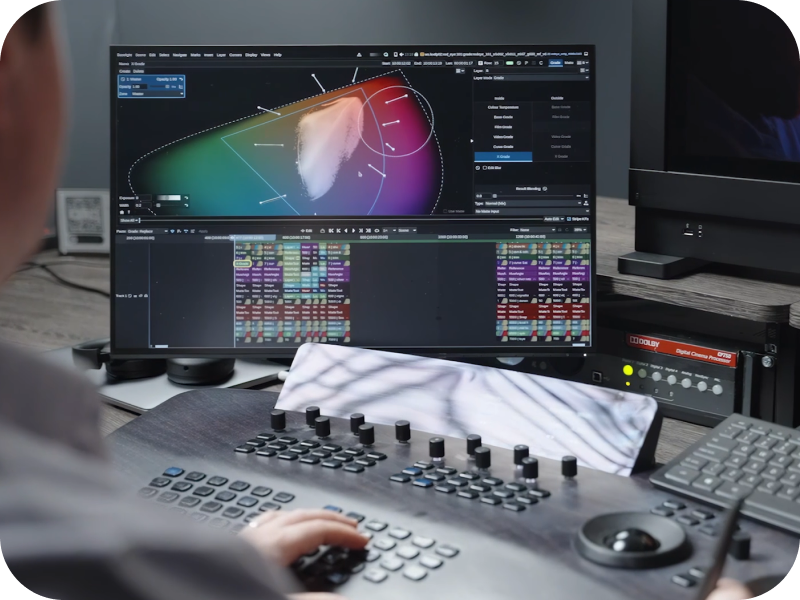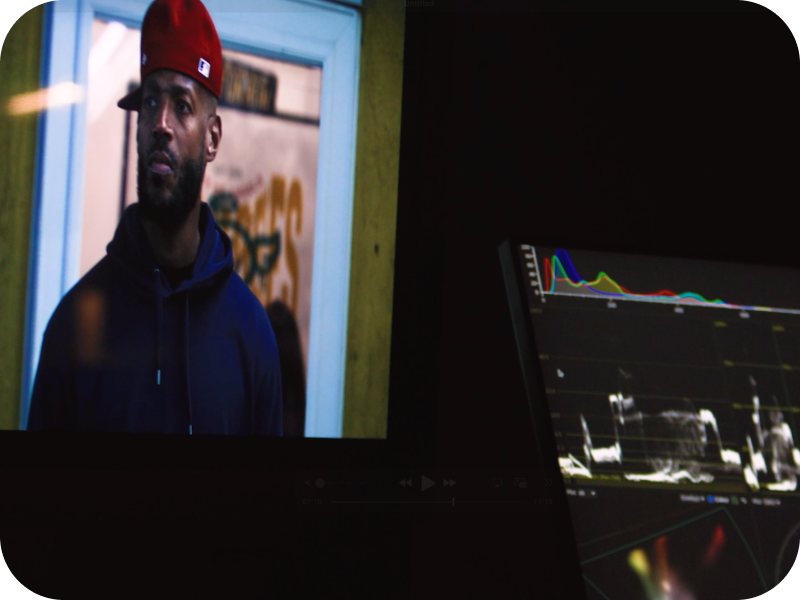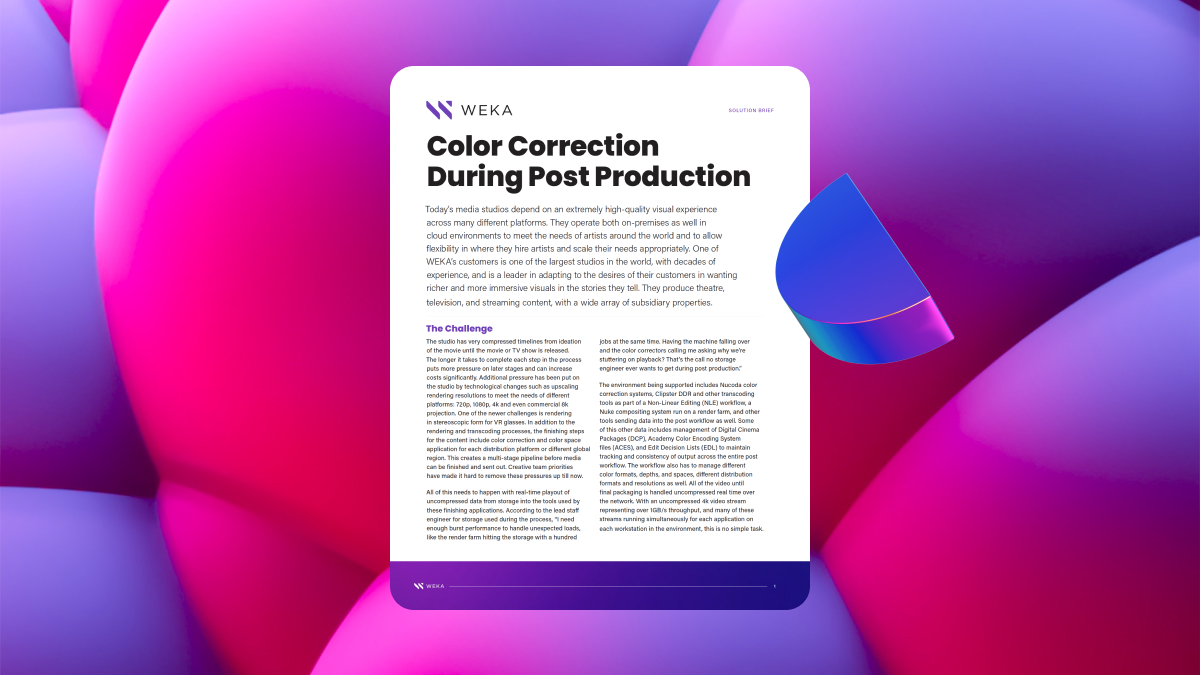Post-Production Powerhouse Partners with WEKA to Streamline
Its Color Science and Finishing Workflows
The Industry Transition to Digital
A love of movies and a passion for the creative process unites and drives Picture Shop’s finishing artists and technical experts, many of whom honed their craft as the industry made the evolutionary jump from film to digital. The ability to use digital cameras to create films and episodic content has created enormous opportunities and challenges for filmmakers as they seek to push creative boundaries while still preserving the unique aesthetic that previously could only be achieved with film.
“There was a very interesting hybrid workflow for about a decade as the film guys tried to make digital work like the film. Today, a third aesthetic has emerged that leverages both digital and film. Rather than trying to make one look like the other, it takes the best of both to form a new aesthetic,” said Peter Doyle, Senior Supervising Colorist at Picture Shop.
In the past, color grading could only be applied to some parts of a film project, but technological advancements have made it possible to marry film and digital mediums and color-grade entire movies or episodics to produce unique aesthetics and visual effects that play a major role in the visual storytelling process.

“The line between color correction and visual effects is blurring, if not completely gone at this point. We’re not just colorists anymore—we’re becoming finishers—I’ve started to prefer that name to describe what we do,” said Doug Delaney, Senior Supervising Colorist at Picture Shop. “We always need to be at the forefront of technology, so it’s never a dull moment. You’re always learning, always progressing, always evolving.”
Balancing Art & Technology

The rise of streaming entertainment has fueled a boom in digital film making and post-production projects, putting sought-after artists like Doyle and Delaney in high demand. It also necessitates a constant balancing act between art and technology. As filmmakers can now view and interact with footage almost immediately, playback issues and production delays in the post-production process have become unacceptable.
Color and finishing artists work with directors, leveraging globally distributed creative teams to ensure their creative visions are realized. However, tight deadlines and the need to balance heightened client expectations for a flawless post-production experience can create tensions, and any technological issues in the editing suite only compound those tensions.
No one is more familiar with the delicate balancing act of art and technology than Picture Shop’s Director of Engineering and Color Science, JD Vandenberg. Vandenberg is responsible for building and maintaining the data infrastructure systems that support Picture Shop’s creative teams and make the finishing process as seamless as possible for the colorists and their clients.
“The best engineering team is the invisible engineering team,” Vandenberg says. “The colorists should never hear from us because everything should just go. But when it doesn’t work, I hear from them immediately.”
“I seek to provide a calming, creative space. If the technology gets in the way of that, it’s frustrating, disappointing, and potentially very disruptive to the creative process and the experience of the filmmakers.”
The Challenge
As the number of artists working simultaneously and the projects and file sizes under management grew, the Picture Shop team encountered frequent playback and performance issues. It also made it challenging for teams to work on various aspects of the project simultaneously, causing costly disruptions to post-production workflows and client presentations.
“One of the turning points for me was the reliability of playback. We are balancing multiple projects, multiple episodes, multiple shows, and multiple team members. We weren’t getting the expected performance and playback—not only for our clients but, frankly, for ourselves. That quickly became an unacceptable way of working,” said Delaney.

To avert playback issues, Vandenberg and his team had to rely on time-consuming, resource-intensive, and often unreliable manual processes that would disrupt creative operations and could not deliver the desired client experience.
“There’s a mitigation method we use when storage cannot perform 100% at the needed rate called caching. A lot of color correctors are built with caching in mind because finding storage that can reach the necessary speed has always been a problem,” said Vandenberg.
The Solution
When searching for a solution, Vandenberg’s mandate from his creative counterparts was simple: We need reliable playback. He and his team quickly discovered WEKA and ran a proof of concept.
“The numbers were astonishing, so we quickly decided the WEKA Data Platform was the way to go,” said Vandenberg. When you start using storage that does not have all these limitations, a new world suddenly opens up of simpler workflows and operations. When you press play—it plays.”
“When we switched to WEKA, my whole team and I noticed an immediate change because we no longer had to prepare for sessions. They were just available to us at any given time, allowing us to focus on the creative process and not worry about the technology and playback.”
Cutting-Edge Creativity
Powered by WEKA
In a field where art and technology are inextricably intertwined, removing creative barriers allows artists to focus on bringing their client visions. The WEKA Data Platform enabled Picture Shop’s finishing teams to work efficiently in parallel without scheduling their workloads around client meetings or worrying about managing their data infrastructure to ensure reliable playback in client presentations.
“WEKA has brought stability, reliability, and predictability,” Doyle commented. The typical panicked phone calls of “I’m about to have a session with a client, and I need playback—can everybody get off the SAN?” don’t happen with WEKA, which is a godsend.”

With WEKA, Vandenberg and his team have future-proofed their data infrastructure stack with a solution that can dynamically scale up and down with each project and grow with Picture Shop’s business as it grows. The WEKA has transformed how their team works, helping them stay ahead of the game in an industry that’s constantly pushing boundaries. “Success for me looks like a colorist telling me their session with clients went great. That’s success.”
“The WEKA platform makes my life a lot easier. I sleep better at night. It’s a new way of thinking about storage, a new philosophy.”
Outcomes with WEKA
Optimized
parallel workflows
With WEKA, Picture Shop’s global team can work efficiently in parallel without concerns about interference or slowdowns.
Reliable
data management
The WEKA Data Platform makes it possible for Picture Shop’s team to meet their tight deadlines and allows their finishing artists to focus on the creative process rather than managing and worrying about the technology.
Zero
caching required
WEKA removes the need to manage the cache, freeing up administrative resources, lowering costs, and ensuring that client sessions run smoothly.
Powering Post-Production and the Creative Process
Learn more about how Picture Shop and WEKA power the creative process in post-production.


Dive a little deeper


